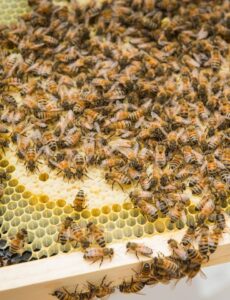We recently hired a staff of 10,000.
Kansas City’s first corporate-sponsored beehive— was installed at our downtown headquarters.
The hive, home to roughly 10,000 honey bees along with its royal inhabitant, the queen, will eventually provide honey for the Live Blue Kitchen and Café. The café features dishes that incorporate locally farmed, sustainable ingredients for Blue KC’s 1,000 employees.
For our beehive staff, the quest for a corporate beehive wasn’t just a pet project, but a passionate endeavor. “Bees are vitally important to local and global food production. It’s important to think globally and act locally,” our beehive staff said.
Bees are the predominant insect pollinators of leading fruit, vegetables and seed crops, transferring pollen from the male  to the female parts of the plants. Without them, we would be in a pickle (which come from cucumbers, and you guessed it, are pollinated by bees.)
to the female parts of the plants. Without them, we would be in a pickle (which come from cucumbers, and you guessed it, are pollinated by bees.)
Bee colonies have been declining worldwide, for reasons not completely understood. Theories include loss of habitat, pesticides, mites, genetics or a combination of the above.
So why did we want to bring a colony to Blue KC? We wanted to help bring urban beekeeping to the area to help both re-establish the bee population and educate on the importance of bees in our ecosystem.
Unfortunately, after making it through the past winter, the Blue KC beehive bee colony collapsed. It wasn’t for lack of food; the bees left between 5 and 10 pounds of honey that our beehive staff will harvest.
While saddened by the loss, our beehive staff are anything but quitters. “At the end of the day we cannot control nature and this was and is a great learning experience. We got another round of bees to start the process all over again. Hoping this time they’ll stay for the long term.”
This March, we released the new queen and bees into the Blue KC beehive with the help of our mentor, Clayton Lee, President of Missouri Bee Keepers Association.
Once established, the hive will produce about 50 pounds of excess honey per season.
Follow our monthly series, where we’ll go into more detail about the new hive, the journey from hive to table and share recipes featuring fresh honey.

